When traveling with a service dog, there are many things to consider. This guide will help you prepare for traveling with a service dog, and provide valuable information for business owners and members of the general public who may encounter someone traveling with a service dog.
Some of the links below are affiliate links, which means if you choose to make a purchase, I will earn a commission. This commission comes at no additional cost to you.
Preparing Your Service Dog for Travel
For people with disabilities, having a service dog can be a physically and emotionally liberating experience. For those of us who love to travel, it’s natural that our service dogs will join us on the journey. As humans, we travel because we want to experience new places, sights, sounds, and events outside our normal day-to-day life. We must remember that these experiences may also be new to our service dog, who doesn’t understand why he or she is away from everything familiar, sleeping in a hotel room or relative’s home, and thrown into a brand-new environment. Even the most well-adjusted and well-trained service dog may be afraid or behave differently. It’s important to prepare for traveling with a service dog as much as possible in advance.

Karin and Aria in Times Square, New York City. I prepared Aria for traveling to busy environments using the methods in this guide.
Tips for Training Your Service Dog for New Environments
Rural to Urban
If you live in a rural area and are traveling with a service dog to an urban area, there are ways to simulate the big city experience without leaving town.
Traffic
Walk your service dog adjacent to busy roads, such as a frontage road near a freeway, to get them used to the sound of heavy traffic, cars speeding by, and horns honking.
Crowds
Attend a local fair or convention where there will be crowds, so that your dog learns to walk among people without bumping into them or getting their leash tangled around someone’s legs. Attend a concert or sports event to prepare your service dog for city noise. Even if you live in a small town, chances are your local high school has a well loved football or basketball team with home games, where there will be costumed mascots, flags waving, and people cheering.
Sirens
Sirens are a much more common sound in urban areas. Spend time near your local fire station, police station, or hospital so your service dog gets used to the sounds and flashing lights.
Construction
Cities often have many construction sites underway, so visit a local one to get your service dog accustomed to the sound of hammers and saws. Walk your dog near and under the scaffolding, as it is often found above sidewalks in urban construction areas.
Desensitization using recordings
Using recorded sounds can be helpful, but they’re not a complete solution. Any sound that plays through speakers has a different tone and resonance than what is heard live. For example, my service dog has no problem with music blasting through speakers, but will sometime shy away from an acoustic guitar being played too close to her. You can use recordings as a preliminary desensitization technique, but your dog eventually needs to adjust to the sounds in person.
If possible, of course it’s best to spend time in a nearby city or large town before you go on a longer trip. Practice crossing busy streets and make sure your dog knows to stand behind the curb if you’re waiting to cross.
Urban to Rural
Going from an urban to rural environment isn’t typically as difficult, but there are a few things you can train for to make traveling with a service dog go more smoothly.
Animals
Rural environments have animals that your dog may never have seen before. Go to a large city park and make sure your dog can focus on you if he sees a squirrel or pigeon. Most cities have a picturesque area where people can hire horse drawn carriages; go there to prepare your dog to meet horses and livestock. Be sure to always keep a reasonable distance from the other animals. You don’t want to stress or upset them with your training exercise.
Train a reliable recall
If you’re planning to go hiking or spend time outdoors, you need to carefully consider whether you will allow your service dog to be off leash, and under what circumstances. Although it’s tempting to want to give them a chance to roam, there are many potential dangers your dog could face, such as poisonous snakes, toxic plants, and dangerous animals, including other off leash dogs that may not be well socialized. Before even considering letting your dog off leash in an unenclosed area, your dog must have a rock solid recall. No matter what is happening, he must come when you call. You can improve your dog’s recall with positive methods using the book Really Reliable Recall.
A safer alternative to allowing your dog off leash is to use a long line, or flexi leash. Many trainers and handlers don’t care for flexi leashes, but in this situation, they can give your dog freedom, but also provide you with more control. Your dog should still have a strong recall, and be trained to check in with you periodically.
Service dog Jellybean and handler Adrienne ride the bus
Practice using public transportation
If you don’t usually take public transportation, but you will on your trip, take a practice ride near your home. Depending on your service dog’s comfort level, you may want to practice in stages. Start by spending time near the bus stop or at the train or subway station and get your dog accustomed to the sights, sounds, and smells. Once your dog is calm in the station environment, take a short ride at an off-peak time when the bus or train isn’t crowded. If that goes well, you can try a rush hour ride.
Work with what you have. Buses and trains aren’t exactly the same experience, but practicing one will help your dog feel more comfortable about the other.
Air Travel with a Service Dog
I’ve flown with a service dog, years ago, but not since 2000 as I struggle with a flying phobia. I prefer staying on the ground and enjoying the open road. Therefore I’ve asked my good friend, Adrienne Webb, to contribute to this portion of the guide. She and her PTSD and mobility service dog, Jellybean, regularly fly to and from the United States and Canada. Here are some of her tips for airline travel with a service dog.
Visit the airport for practice first
If possible, get a tour of the airport a few days or weeks before you fly. If you can, go through security or ask the tour guides to practice using a handheld scanner on your dog. Find out where the dog relief areas are, either on the tour or by looking online.
Get vaccination records and other important paperwork
The TSA wants to ensure that all animals traveling aboard aircraft have had their rabies vaccination. It’s also a good idea to carry vaccination records for general safety and preparedness. Some dog-related locations and events require proof of vaccination.
If you have a psychiatric service dog or an emotional support animal, you should carry a letter from your doctor stating your need for the animal. There’s no harm in obtaining one of these for any type of service dog. A dog that is wearing a vest and behaving properly will most likely be accepted without too many questions, but especially if you have an invisible disability, it’s a good idea to carry documentation. Unfortunately, there are many people out there who pass off pet dogs as service dogs, and the most common place to do it is at the airport. No one wants to put their beloved pet in cargo. While I can understand this concern, the solution isn’t to lie about the nature of your dog, it’s to pressure airlines to provide cabin space for pets and/or make cargo holds safer.
It’s also important to bring a copy of the relevant laws for your country. Always have a copy of the ADA Service Dog Questions and Answers and Air Carrier Access Act on your phone or printed out, as well as the policy of the airline you are using. Airline personnel should know the laws, but sometimes they don’t, and being able to show them the rules can help defuse a situation.
Pack emergency medications and a mess kit for your service dog
Even a well-trained and well-traveled service dog can get nervous or become airsick on the plane. Consider obtaining a mild sedative from your veterinarian. Ask your vet about the following over-the-counter medications: Imodium in case of diarrhea, Pepto-Bismol tablets in case of upset tummy, and Benadryl or Dramamine for mild sedation and to reduce nausea. You probably won’t need these medications, but bring them just in case. If the worst does happen, be prepared by packing an emergency mess kit, including puppy pads, baby wipes, and poop bags.
Consider limiting food and water before a flight
Adrienne doesn’t give Jellybean food or water 8 hours before a flight. After going through Customs, she will give her some ice cubes. The best way to avoid potty accidents and vomiting is to prevent them in the first place.
Bring dog supplies in a carry-on bag
Airlines are not allowed to charge extra for bags that only contain medical equipment. Service dogs are considered to be medical equipment, so you can carry a second bag on the plane with essentials for your dog. Besides the above listed items, bring a toy or two, a bone or something to chew on, a mat or blanket, any regular medications your dog takes, and portable food and water dishes. It’s also a good idea to bring a couple of days worth of food, in case your checked luggage gets lost.
For more tips on flying with a service dog and flying with a disability, you may find these guides helpful:
Air Travel for Wheelchair Users
Hotels and Service Dogs
If you’re traveling with a service dog, chances are you’ll probably want to stay in a hotel at some point. As public accommodations, hotels are covered by the Americans with Disabilities act, and must allow service dogs in rooms and public areas of the facility. The hotel cannot charge you a pet deposit or extra fee for your service dog – unless the dog causes damage. Hair on furniture is considered to be routine wear and tear (humans shed, too!) and you cannot be charged a cleaning fee. The hotel must allow your dog in all public areas, including meeting rooms, the fitness center, and the pool room (but not in the pool.) Never leave your service dog unattended in the hotel room. Even a normally well-behaved dog could become distressed and bark or cause damage.
When choosing a potty area for your dog, be a polite guest and find an out-of-the-way area, such as the back of the parking lot, where there is no fancy landscaping and guests will not be walking through the grass. Be sure to poop scoop regularly and don’t leave a mess behind.
Tips to Keep Your Service Dog Comfortable While Traveling
Bring special treats
Traveling with a service dog can be stressful for you and the dog. A dog who usually has a healthy appetite may lose interest in their meals. It’s a good idea to bring extra yummy treats or a vitamin gravy to add to their food.
If you’ll be taking a long car or plane ride, or sitting for hours at a conference, bring something to occupy your dog, such as a favorite chew toy or bone. When I travel, I often go out to dinner with friends, and we may sit in a restaurant for hours talking. Aria has chewed through three harnesses while on trips, because she got bored lying under the table. Note: don’t give any type of table scraps, and avoid treats or bones with strong odors. You don’t want to encourage your dog to beg, or for the smell of their treats to annoy the people sitting around you. A plastic Nylabone is a great choice for public settings.
Allow extra time for “go potty”
We would all rather go to the bathroom at home, and dogs are no exception. When traveling with a service dog, you may find that the only available potty areas are very different from your dog’s usual facilities. For example, in a city, there may be only gravel or concrete areas in which to go, or sand in the desert, or snow in the winter. Most well-trained dogs won’t start pottying indoors. They will just stop going, for as long as possible. I’ve seen them wait more than 24 hours if they are really unhappy with the accommodations. Be patient, give extra time, lots of water, and praise for success. Your dog will adjust eventually.
Always carry water
When traveling with a service dog, it’s a good idea to keep water with you at all times. It’s easy to get caught up in your trip and find that there’s no ready source of water available, or only expensive bottled water at events. Get a reusable bottle especially for your dog, and/or a collapsing or folding dog bowl, and refill the bottle every morning before you go out on your adventures.
Use a secure harness or crate
If you’re traveling with a service dog, it’s essential to keep them safe in your vehicle. Dogs that are not secured in the car can be injured or killed even in minor accidents, or become a projectile and harm another passenger. Purchase a car harness that can attach to a seatbelt, or place your dog in an airline approved crate. Don’t forget to attach the crate to a secure point in the vehicle using tiedowns.
Essentials for Exploring
Over the years, I’ve tried many products for traveling with a service dog, and found some favorites that work well in a variety of situations. Here are my recommendations.



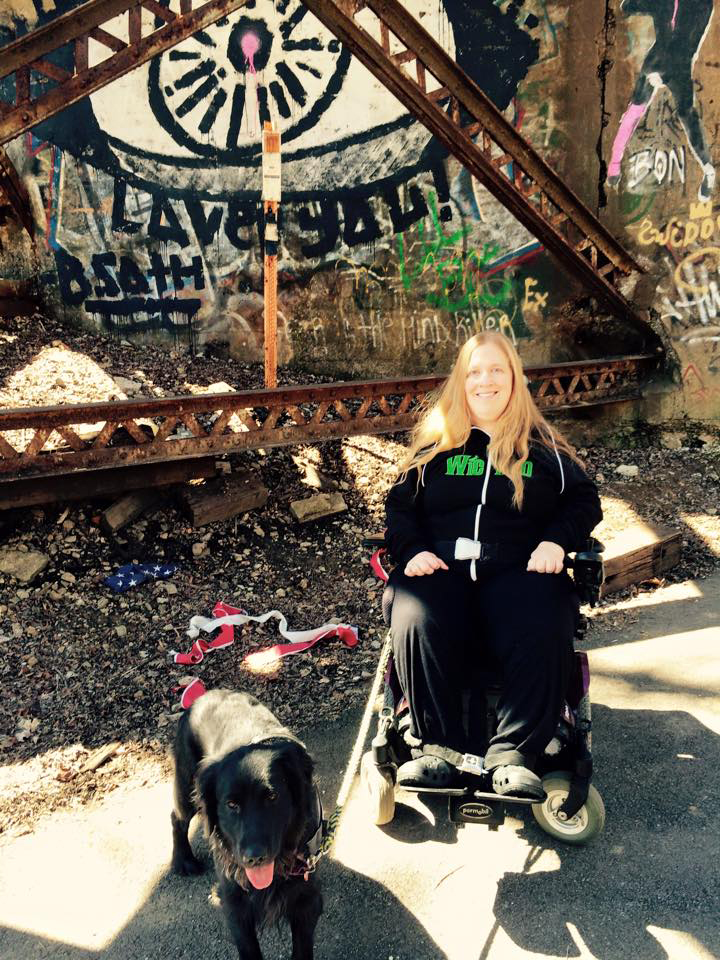
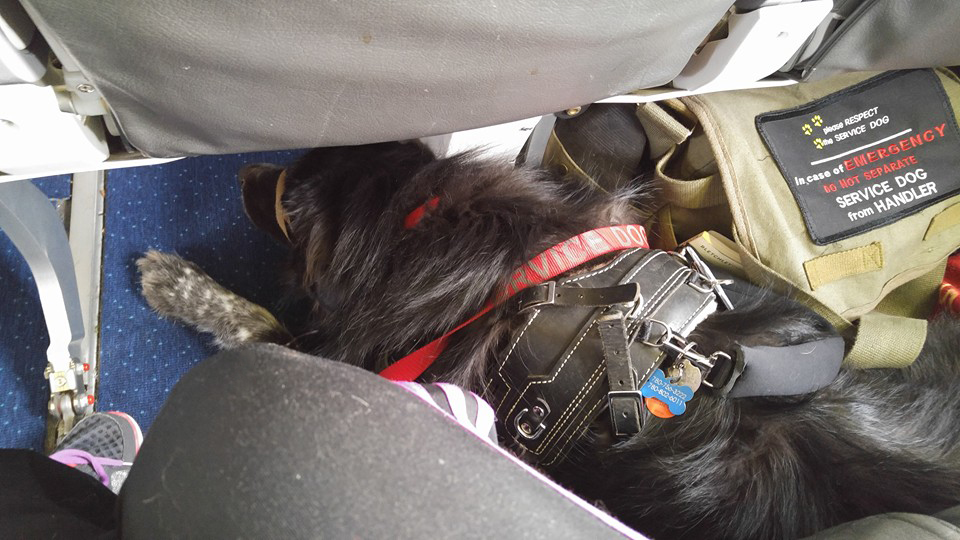
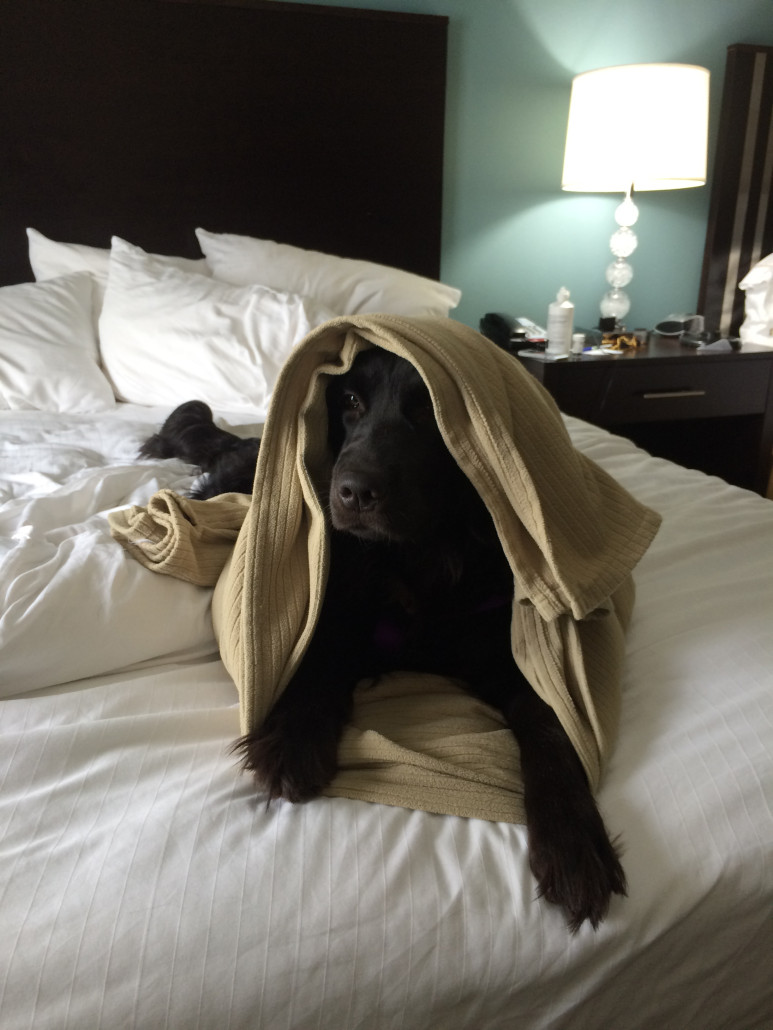
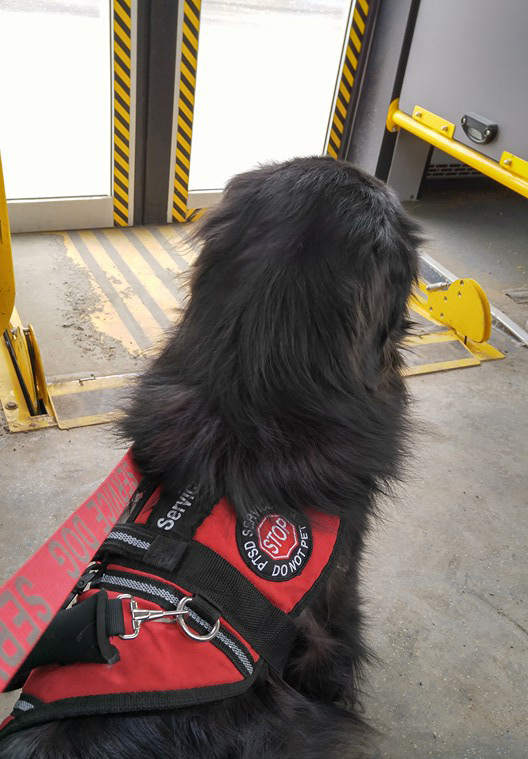

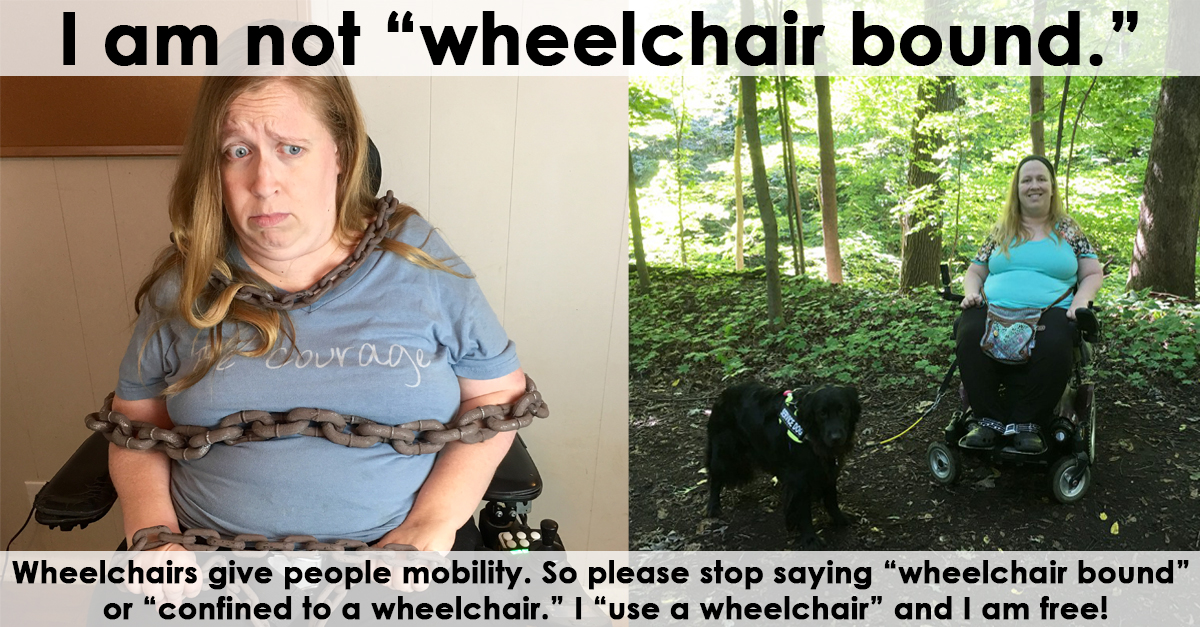


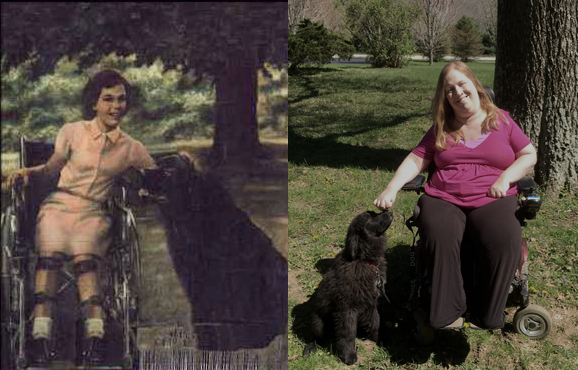


My service dog loves traveling. She’s so pleased when we get in the car with the people we travel with for my work the most often. Her favorite, though, is when we travel by train. I’m not entirely sure why. She does her happy feet tapping (she stands in place and lifts and lowers her front paws?) and sometimes wags a bit when the train pulls up to the platform. Her least favorite so far is plane, though she isn’t really bothered by it- it’s just that she’s less perky looking about the ears than normal, kind of like when she signals me about something and I signal back her wait signal because it’s not safe for me to stop what I’m doing abruptly. Unless you count her first time on the kayak lol! (She’s adjusted to being fine once we get going, and even seems happy enough as long as she doesn’t get dumped in the water.)
One thing I did forget to mention: she prefers to do her business in the grass, which is hard when we travel to a city. 🙁